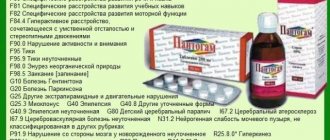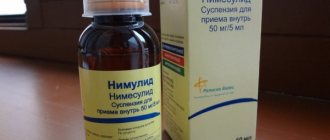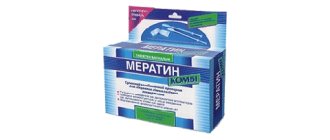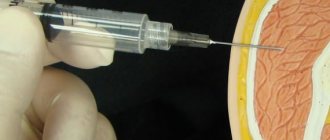Compound
| Pills | 1 table |
| active substance: | |
| calcium hopanthenate (Pantogam®) | 250 mg |
| 500 mg | |
| excipients: methylcellulose - 0.8/1.6 mg; calcium stearate - 3.1/6.2 mg; magnesium hydroxycarbonate - 46.8/93.6 mg; talc - 9.3/18.6 mg |
| Syrup | 100 ml |
| active substance: | |
| calcium hopanthenate (Pantogam®) | 10 g |
| excipients: glycerol (in terms of 100%) - 25.8 g; sorbitol - 15 g; citric acid monohydrate - 0.1 g; sodium benzoate - 0.1 g; aspartame - 0.05 g; food flavoring “Cherry 667” - 0.01 g; purified water - up to 100 ml |
Interaction with other drugs
During a general examination and medical history, the doctor carefully finds out what medications the patient uses. This is especially important since Pantogam affects other medicines. All drugs that penetrate the blood-brain barrier into the brain are taken into account. Detects the following drug interactions:
- Phenobarbital, Carbamazepine, neuroleptics - strong anticonvulsant effect;
- barbiturates - increase the duration of action;
- Glycine, etidronic acid - enhances the effect of Pantogam;
- local anesthetics (lidocaine, novocaine) - enhanced anesthetic effect.
If there is no compatibility, only one of the remedies that will be most important to the patient is used. When cross-reaction occurs, one of the drugs may cause side effects. In this case, the medications are discontinued and the patient’s well-being is monitored. Then the most important drug is re-prescribed for use, gradually increasing the dosage so that the therapeutic effect occurs.
It is important that Pantogam reduces the side effects of Phenobarbital. This is convenient for patients who cannot take other medications besides it. Therefore, Pantogam is often combined with Phenobarbital, even in the absence of urgent need.
Directions for use and doses
Orally, 15–30 minutes after eating.
Common for tablets
Adults: single dose - 0.25-1 g, daily dose - 1.5-3 g; children: single dose - 0.25-0.5 g, daily dose - 0.75-3 g. Course of treatment - 1-4 months, in some cases - up to 6 months. After 3–6 months, a second course of treatment is possible.
For tablets 250 mg
For epilepsy: in combination with anticonvulsants - 0.75–1 g/day. The course of treatment is up to 1 year or more.
For extrapyramidal neuroleptic syndrome: in combination with ongoing therapy, daily dose - up to 3 g, treatment for several months.
For extrapyramidal hyperkinesis in patients with hereditary diseases of the nervous system: (combined treatment) - 0.5–3 g/day. The course of treatment is up to 4 months or more.
For the consequences of neuroinfections and head trauma: 0.25 g 3-4 times a day.
To restore performance under increased loads and asthenic conditions: 0.25 g 3 times a day.
For the treatment of extrapyramidal syndrome caused by taking antipsychotics: adults - 0.5–1 g 3 times a day; children - 0.25–0.5 g 3–4 times a day. The course of treatment is 1–3 months.
For tics: children - 0.25–0.5 g 3–6 times a day, for 1–4 months.
For urinary disorders: adults - 0.5–1 g 2–3 times a day; children - 0.25-0.5 g (daily dose - 25-50 mg/kg). The course of treatment is 1–3 months.
For children with various pathologies of the nervous system: depending on age, the drug is recommended in a dose of 1–3 g. Tactics for prescribing the drug: increasing the dose over 7–12 days, taking the maximum dose for 15–40 days and gradually reducing the dose until Pantogam is discontinued ® for 7–8 days. The break between courses of Pantogam®, as for any other nootropic drug, ranges from 1 to 3 months.
For tablets 500 mg
For cognitive impairment due to organic brain lesions, incl. for the consequences of neuroinfections and head injury, and neurotic disorders: 0.25 g 3-4 times a day.
For extrapyramidal hyperkinesis in patients with hereditary diseases of the nervous system in combination with ongoing therapy: in a dose of 0.5 to 3 g per day. The course of treatment is up to 4 months or more.
For the treatment of extrapyramidal syndrome caused by taking antipsychotics: adults - in a dose of 0.5 to 1 g 3 times a day; children - in a dose of 0.25 to 0.5 g 3-4 times a day. The course of treatment is 1–3 months.
For epilepsy with slowing of mental processes in complex therapy with anticonvulsants: adults - in a dose of 0.5 to 1 g 3 times a day; children - in a dose of 0.25 to 0.5 g 3-4 times a day. The course of treatment is up to 6 months.
For psycho-emotional overload, decreased mental and physical performance, to improve concentration and memory: 0.25 g 3 times a day.
For neurogenic urination disorders: adults - in a dose of 0.5 to 1 g 2-3 times a day; children - in a dose of 0.25 to 0.5 g 3 times a day (daily dose is 25–50 mg/kg). The course of treatment is 1–3 months.
For children with various pathologies of the nervous system: depending on age, the drug is recommended to take up to 3 g per day (6 tables). Tactics for prescribing the drug: increasing the dose over 7–12 days, taking the maximum dose for 15–40 days and gradually reducing the dose until Pantogam® is discontinued over 7–8 days. The break between courses of Pantogam®, as for any other nootropic drug, ranges from 1 to 3 months.
Children with developmental delay: 0.5 g 3-4 times a day. The course of treatment is 2–3 months.
Children with attention deficit hyperactivity disorder: depending on body weight, the drug is prescribed at an average therapeutic dose of 30 mg/kg per day, morning and afternoon, with dose titration over the first 5–7 days. The course of treatment is 3–4 months.
For children with neurosis-like conditions (tics; stuttering, mainly in the clonic form): in a dose of 0.25 to 0.5 g 3-6 times a day. The course of treatment is 1–4 months.
Taking into account the nootropic effect of the drug, it is preferably taken in the morning and afternoon (up to 17:00).
Syrup
Adults: single dose - 2.5-10 ml (0.25-1 g), daily dose - 15-30 ml (1.5-3 g); children: single dose - 2.5-5 ml (0.25-0.5 g), daily dose - 7.5-30 ml (0.75-3 g). The course of treatment is 1–4 months, sometimes up to 6 months. After 3–6 months, a second course of treatment is possible.
Children, depending on age and pathology of the nervous system: the following dose range is recommended: children of the first year - 5-10 ml (0.5-1 g) per day, up to 3 years - 5-12.5 ml (0.5- 1.25 g) per day, children from 3 to 7 years old - 7.5-15 ml (0.75-1.5 g), over 7 years old - 10-20 ml (1-2 g). Treatment tactics include increasing the dose over 7–12 days, taking the maximum dose for 15–40 days or more, with a gradual dose reduction until discontinuation within 7–8 days. The course of treatment is 30–90 days (for some diseases up to 6 months or more).
For schizophrenia: in combination with psychotropic drugs - from 5 to 30 ml (0.5–3 g) per day. The course of therapy is from 1 to 3 months.
For epilepsy in combination with anticonvulsants: in a dose of 7.5 to 10 ml (0.75–1 g) per day. The course of therapy is up to 1 year or more.
For neuroleptic syndrome accompanied by extrapyramidal disorders: daily dose - up to 30 ml (up to 3 g), treatment for several months.
For extrapyramidal hyperkinesis in patients with organic diseases of the nervous system: from 5 to 30 ml (0.5–3 g) per day. The course of treatment is up to 4 months or more.
For the consequences of neuroinfections and head trauma: from 5 to 30 ml (0.5–3 g) per day.
To restore performance under increased stress and asthenic conditions: 2.5–5 ml (0.25–0.5 g) 3 times a day.
For urinary disorders: children - 2.5-5 ml (0.25-0.5 g), daily dose - 25-50 mg/kg, course of treatment - 1-3 months; adults - 5-10 ml (0.5-1 g) 2-3 times a day.
In conditions of long-term treatment, simultaneous administration of the drug with other nootropic and stimulant drugs is not recommended. Taking into account the nootropic effect of the drug, it is preferably taken in the morning and afternoon.
special instructions
When using a short course of treatment, the medicine can be used with other nootropic drugs. If treatment is carried out for more than 1 month, it is better to use only 1 drug. The risk of sudden side effects will increase.
When using Pantogam, you need to be careful about your well-being in the first 2 weeks of the course. This is due to the fact that concentration may decrease, so it is better to stop driving a vehicle. If this effect does not occur in the future, the ban on driving a car or operating heavy machinery is lifted.
The medicine can cause an overdose, which will cause a significant deterioration in the patient’s well-being.
Therefore, it is prohibited to use the product not according to the instructions from the doctor. In case of overdose, sleep disturbance is noted. The person may experience insomnia or drowsiness. There is noise in the ears and headache.
In this case, it is recommended to drink activated carbon and consult a doctor. If your health continues to deteriorate, he will prescribe gastric lavage and symptomatic therapy.
Release form
Tablets, 250 and 500 mg. In a blister pack made of PVC film and aluminum foil, 10 tablets each. 5 contour blister packs are placed in a cardboard pack.
Syrup, 100 mg/ml. In dark glass bottles of 100 ml, sealed with caps with a control ring for the first opening. Each bottle together with a measuring spoon with a nominal volume of 5 ml with a line marked “1/2” (corresponding to 2.5 ml) or with a measuring spoon with a nominal volume of 5 ml with lines marked “1/4” and “1/2” (which corresponds to 1.25 ml and 2.5 ml) are placed in a cardboard pack.
What is the best way to choose an analogue for children?
The choice of analogue for children is especially important. It is better not to make a replacement on your own, since parents do not always take into account indications and contraindications, relying only on cost. If the current active ingredient is suitable, use products containing an identical active ingredient, that is, calcium hopanthenate. In this case, Pantocalcin and Gopantam are suitable. The dosage will remain identical, but parents will spend less money on treating their child.
When choosing a medicine with another main active ingredient, you must carefully read the instructions for use. Not all of them are approved for use by children. Pantogam differs in that it is produced in syrup, so it can be consumed even by infants.
Some analogues have not undergone sufficient clinical trials (Mexidol) for children, so it is recommended to choose other medications that are fully approved by doctors.
If analogues are used in tablet form, they can be prescribed only from 3 years of age. But for each use of the drug in this case, you will need to undergo a full examination and collect an anamnesis.
Pantogam price, where to buy
The cost of the drug Pantogam depends on its pharmacological form (tablets for adults and children over 3 years of age or syrup for children), as well as on the region and pharmacy chain.
On average, you can buy Pantogam in Russian pharmacies:
- price of Pantogam tablets 500 mg No. 50 – 550 rubles;
- price of Pantogam for children from 3 years old in tablets 250 mg No. 50 – 350 rubles;
- price of Pantogam syrup for children from 0 months 10% 100 ml No. 1 – 350 rubles.
- Online pharmacies in RussiaRussia
- Online pharmacies in KazakhstanKazakhstan
ZdravCity
- Pantogam tablets 250 mg 50 pcs. PIK-PHARMA PRO LLC/PIK-PHARMA LEK LLC
467 rub. order - Pantogam syrup 10% 100mlVips-Med/Pik-Pharma
479 RUR order
- Pantogam tablets 500 mg 50 pcs. PIK-PHARMA PRO LLC/PIK-PHARMA LEK LLC
RUR 695 order
- Pantogam active capsules 300 mg 60 pcs. PIK-PHARMA PRO LLC/PIK-PHARMA LEK LLC
640 rub. order
Pharmacy Dialogue
- Pantogam (syrup 10% 100ml)Pik-Pharma Lek
RUR 484 order
- Pantogam tablets 500 mg No. 50Pik-Pharma Lek
RUR 702 order
- Pantogam Active capsules 300 mg No. 60Pik-Pharma Lek
625 rub. order
- Pantogam (tab. 250 mg No. 50) Pik-Pharma Lek
RUR 469 order
- Pantogam tablets 250 mg No. 50Pik-Pharma Lek
450 rub. order
show more
When is Pantogam or its analogues needed?
Pantogam is an effective remedy with a nootropic and anticonvulsant effect. It is important that it can be used by patients of absolutely any age. It is used to treat newborns and infants, adults and elderly patients. It is often recommended by neurologists, as it has a minimal number of side effects and contraindications.
You can use analogues, but it is important to find out the difference between the drugs and take into account the patient’s medical history.
They must first undergo a general examination and laboratory and instrumental examinations. Then the risk of sudden, unexpected side effects is significantly reduced. In therapy and neurology for adults, one of the presented analogues can be used if it is suitable for the indications for use. When it comes to pediatrics, it is better to use medications that have undergone clinical trials. Their effective action has been proven, all negative aspects have been identified.





